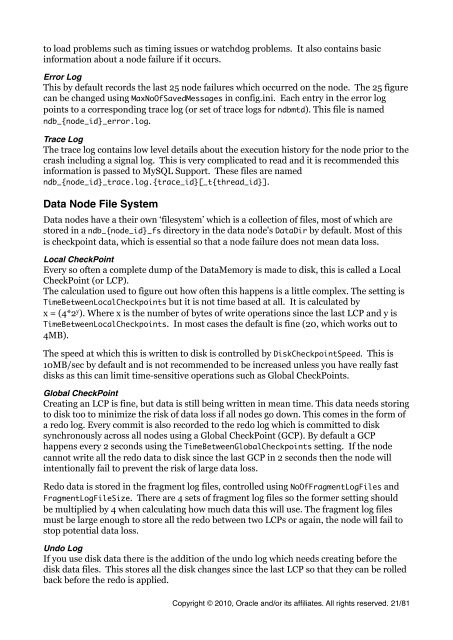MySQL Cluster Tutorial - cdn.oreillystatic.com
MySQL Cluster Tutorial - cdn.oreillystatic.com
MySQL Cluster Tutorial - cdn.oreillystatic.com
Create successful ePaper yourself
Turn your PDF publications into a flip-book with our unique Google optimized e-Paper software.
to load problems such as timing issues or watchdog problems. It also contains basic<br />
information about a node failure if it occurs.<br />
Error Log<br />
This by default records the last 25 node failures which occurred on the node. The 25 figure<br />
can be changed using MaxNoOfSavedMessages in config.ini. Each entry in the error log<br />
points to a corresponding trace log (or set of trace logs for ndbmtd). This file is named<br />
ndb_{node_id}_error.log.<br />
Trace Log<br />
The trace log contains low level details about the execution history for the node prior to the<br />
crash including a signal log. This is very <strong>com</strong>plicated to read and it is re<strong>com</strong>mended this<br />
information is passed to <strong>MySQL</strong> Support. These files are named<br />
ndb_{node_id}_trace.log.{trace_id}[_t{thread_id}].<br />
Data Node File System<br />
Data nodes have a their own ‘filesystem’ which is a collection of files, most of which are<br />
stored in a ndb_{node_id}_fs directory in the data node's DataDir by default. Most of this<br />
is checkpoint data, which is essential so that a node failure does not mean data loss.<br />
Local CheckPoint<br />
Every so often a <strong>com</strong>plete dump of the DataMemory is made to disk, this is called a Local<br />
CheckPoint (or LCP).<br />
The calculation used to figure out how often this happens is a little <strong>com</strong>plex. The setting is<br />
TimeBetweenLocalCheckpoints but it is not time based at all. It is calculated by<br />
x = (4*2 y ). Where x is the number of bytes of write operations since the last LCP and y is<br />
TimeBetweenLocalCheckpoints. In most cases the default is fine (20, which works out to<br />
4MB).<br />
The speed at which this is written to disk is controlled by DiskCheckpointSpeed. This is<br />
10MB/sec by default and is not re<strong>com</strong>mended to be increased unless you have really fast<br />
disks as this can limit time-sensitive operations such as Global CheckPoints.<br />
Global CheckPoint<br />
Creating an LCP is fine, but data is still being written in mean time. This data needs storing<br />
to disk too to minimize the risk of data loss if all nodes go down. This <strong>com</strong>es in the form of<br />
a redo log. Every <strong>com</strong>mit is also recorded to the redo log which is <strong>com</strong>mitted to disk<br />
synchronously across all nodes using a Global CheckPoint (GCP). By default a GCP<br />
happens every 2 seconds using the TimeBetweenGlobalCheckpoints setting. If the node<br />
cannot write all the redo data to disk since the last GCP in 2 seconds then the node will<br />
intentionally fail to prevent the risk of large data loss.<br />
Redo data is stored in the fragment log files, controlled using NoOfFragmentLogFiles and<br />
FragmentLogFileSize. There are 4 sets of fragment log files so the former setting should<br />
be multiplied by 4 when calculating how much data this will use. The fragment log files<br />
must be large enough to store all the redo between two LCPs or again, the node will fail to<br />
stop potential data loss.<br />
Undo Log<br />
If you use disk data there is the addition of the undo log which needs creating before the<br />
disk data files. This stores all the disk changes since the last LCP so that they can be rolled<br />
back before the redo is applied.<br />
Copyright © 2010, Oracle and/or its affiliates. All rights reserved. 21/81
















